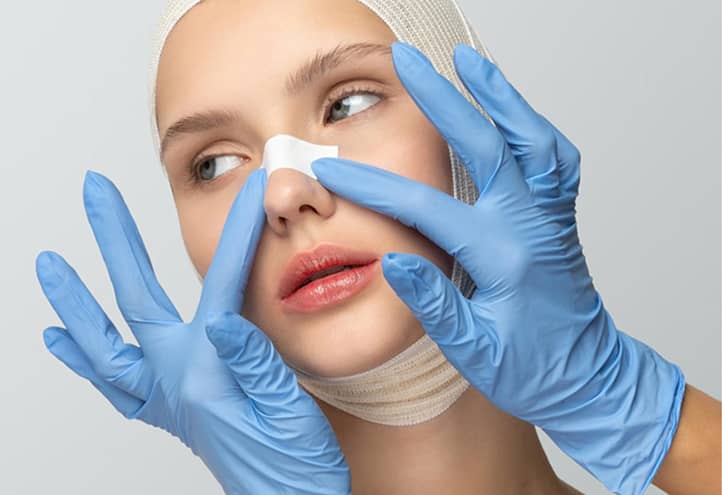Body Dysmorphic Disorder (BDD), is a mental disorder in which a person becomes obsessed with imagined or minor flaws in their appearance. This condition causes significant distress and severely impairs a person’s social, professional, and personal life.
The relevance of the topic of body dysmorphic disorder is hard to overestimate. In an era of pervasive social media influence and unrealistic beauty standards promoted by the media, more and more people, especially young people, encounter this disorder. According to statistics, approximately 2% of the population suffers from body dysmorphic disorder, with women being affected 2-3 times more often than men. It is important to understand the nature and manifestations of this disorder in order to recognize its symptoms in a timely manner and provide effective assistance.

Symptoms and Manifestations of Body Dysmorphic Disorder
Key symptoms of body dysmorphic disorder include an obsessive preoccupation with real or imagined physical flaws, as well as avoiding social situations due to shame about one’s appearance. A person suffering from body dysmorphic disorder spends a disproportionate amount of time checking and concealing their perceived physical flaws.
Characteristic manifestations of body dysmorphic disorder may include:
- Constant mirror-checking and self-assessment.
- Obsessive thoughts and anxiety about specific body parts (e.g., nose size, ear shape, presence of acne, etc.).
- Avoiding photography or refusal to look at photos of oneself.
- Avoiding social contacts and situations where one might be seen.
- Use of makeup, clothing, and other means to mask perceived flaws.
- Frequent visits to cosmetologists or plastic surgeons in an attempt to “fix” imagined defects.
It is essential to note that these symptoms can vary significantly in intensity and frequency among different people. Some patients have more localized issues, while others experience more generalized concerns with body perception.
A characteristic sign of body dysmorphic disorder is that a person becomes entirely absorbed in their perceived flaws, spending most of the day thinking about and concealing them. This leads to significant disruptions in the patient’s social, professional, and personal life. For example, a person may refuse to leave home, avoid meeting friends, or decline important business opportunities out of fear of being seen and judged.
Moreover, some patients with body dysmorphic disorder resort to dangerous or even illegal actions, such as excessive use of cosmetic procedures or plastic surgeries, in a futile attempt to correct imagined defects. This can result in serious physical and psychological consequences.
Thus, body dysmorphic disorder significantly reduces a person’s quality of life, preventing them from fully realizing their potential in various areas. Timely identification and treatment of this disorder are crucial for improving patients’ well-being.

Causes of Body Dysmorphic Disorder
Body dysmorphic disorder, like many other mental disorders, is the result of a complex interaction of various factors. Understanding the etiology of this condition is essential for developing effective methods of therapy and prevention. The study of biological, psychological, and social prerequisites that may lead to an unhealthy preoccupation with one’s appearance is particularly valuable.
Research in this field has identified several key predisposing factors. Some scientists believe that specific genetic and neurochemical characteristics may underlie body dysmorphic disorder. At the same time, psychological factors such as low self-esteem and perfectionism also play a significant role. The influence of social beauty standards promoted by modern media should not be underestimated.
A detailed study of the causes of body dysmorphic disorder allows for a deeper understanding of the nature of this disorder. Only a comprehensive approach, considering biological, psychological, and social aspects, can ensure effective prevention and treatment of this issue.
Biological Factors
Studies show that certain genetic predispositions and neurochemical characteristics may underlie body dysmorphic disorder. For example, body dysmorphic disorder is more common in individuals whose relatives also suffer from this disorder. Additionally, it is thought to be linked to imbalances in serotonin, dopamine, and other neurotransmitters in the brain.
One study conducted with functional magnetic resonance imaging (fMRI) revealed dysfunctions in the fronto-striatal systems of patients with body dysmorphic disorder, which may explain their tendency toward obsessive thoughts and repetitive behavioral patterns associated with self-image.
Psychological Factors
Personality traits play an important role. People with low self-esteem, perfectionistic tendencies, and a propensity for anxiety are more susceptible to developing body dysmorphic disorder. Traumatic experiences, such as being teased about appearance in childhood, can also be a precursor to this disorder.
Studies indicate that patients with body dysmorphic disorderoften hold unrealistic beauty standards and engage in excessive critical self-analysis. They struggle to perceive their appearance adequately, focusing solely on imagined defects.
Social Factors
Modern culture, with its unrealistic beauty standards perpetuated by media and social networks, significantly affects people’s perceptions of their appearance. Constantly comparing oneself to idealized images can lead to body dysmorphic disorder, especially among young people.
Additionally, social stigma related to appearance can contribute to the development of dysmorphic beliefs. People who have experienced ridicule or rejection due to their appearance in the past are particularly vulnerable to developing this disorder.
Thus, body dysmorphic disorder has a multifactorial nature, intertwining biological, psychological, and social aspects. Understanding these mechanisms is crucial for effective diagnosis and treatment of this disorder.

Diagnosis and Treatment of Body Dysmorphic Disorder
Diagnosis of body dysmorphic disorder is typically performed by a psychiatrist or clinical psychologist. The specialist assesses the nature and intensity of symptoms, their impact on the patient’s daily life, and rules out the presence of other mental disorders.
One common diagnostic tool is the Body Dysmorphic Disorder Questionnaire (BDD-Q), which helps identify key signs of body dysmorphic disorder. Additionally, clinical interviews and other psychological tests may be used.
Cognitive-Behavioral Therapy (CBT)
The primary goal of CBT is to change dysfunctional beliefs and behavioral patterns associated with concerns about appearance. The therapist helps the patient recognize the irrationality of their thoughts and develop more adaptive coping mechanisms.
In the course of cognitive-behavioral therapy, patients learn to recognize and challenge automatic negative thoughts related to their appearance. They also undergo behavioral experiments aimed at gradually overcoming avoidance behaviors. This allows them to gain new experiences in interacting with the outside world and reduce symptom intensity.
Pharmacological Treatment
In some cases, especially when there are coexisting anxiety or depressive disorders, antidepressants (such as selective serotonin reuptake inhibitors and tricyclic antidepressants) are prescribed. These help to reduce the intensity of body dysmorphic disorder symptoms.
Studies show that combining antidepressants with CBT yields more effective results compared to each method individually. Pharmacological therapy can be particularly beneficial in the initial stages of treatment when patients find it difficult to concentrate on psychotherapy due to pronounced symptoms.
Auxiliary Methods
Additionally, relaxation techniques, art therapy, hypnotherapy, and other practices aimed at improving self-perception and reducing anxiety may be used.
For example, mindfulness and meditation techniques help patients learn to accept their thoughts and feelings without overreacting to them. Art therapy, in turn, promotes a more positive body image and self-acceptance.
It is important to note that treating body dysmorphic disorder requires time and continuous effort. A comprehensive approach, including psychotherapy and, if necessary, pharmacological therapy, shows the best results. Regular consultations with professionals and following their recommendations are key to overcoming this disorder.
Moreover, successful treatment of body dysmorphic disorder is supported by the involvement of close ones in the therapeutic process. Family and friends can help the patient overcome social isolation and strengthen their confidence in themselves and acceptance of their appearance.


Association of Body Dysmorphic Disorder with Other Mental Disorders
One distinctive feature of body dysmorphic disorder (BDD) is its strong association with other mental disorders. This complicates diagnosis and treatment, requiring a comprehensive approach.
For instance, BDD is often considered a form of obsessive-compulsive disorder (OCD), as it involves intrusive thoughts and repetitive behaviors related to appearance concerns. Additionally, BDD frequently coexists with anxiety and depressive disorders, which further deteriorate patients’ psychological well-being.
Another significant link is with eating disorders. Some studies indicate a high probability of comorbidity between BDD and conditions such as bulimia or anorexia, where individuals employ extreme methods to control their weight and body shape in an attempt to match imposed beauty standards. This connection necessitates special consideration when developing therapeutic strategies.
- Obsessive-Compulsive Disorder (OCD). BDD is often seen as a type of OCD due to its characteristic intrusive thoughts and repetitive behaviors centered around appearance. Approximately 30% of patients with OCD also exhibit BDD symptoms.
- Anxiety and Depressive Disorders. Anxiety and depression are the most common comorbid conditions in BDD. Persistent concerns about appearance and social avoidance can provoke the development of generalized anxiety disorder or clinical depression.
- Eating Disorders. Some studies show high comorbidity between BDD and bulimia or anorexia. Individuals with BDD may resort to dietary restrictions, compensatory behaviors, or excessive exercise to alter their appearance.
- Substance Abuse. Individuals with BDD may use alcohol, drugs, or other substances to temporarily relieve anxiety and distress associated with appearance perception. This can lead to dependency and worsen psychological issues.
Understanding the connection between BDD and other mental disorders is crucial for providing a comprehensive treatment approach.

Body Dysmorphic Disorder and Cosmetic Surgery
A serious issue related to BDD is the overuse of cosmetic procedures and plastic surgery. People with this disorder often seek surgery to correct imagined physical flaws.
Research shows that approximately 7-15% of cosmetic surgery patients have a BDD diagnosis. However, despite undergoing procedures, their concern with appearance typically does not diminish, and in some cases, it even intensifies.
This is due to the psychological nature of BDD, which cannot be resolved solely through physical alterations. BDD patients tend to view any cosmetic interventions as unsuccessful, focusing on new perceived imperfections.
Furthermore, such surgical interventions can lead to severe complications and worsen an individual’s mental health. Dissatisfaction with the outcome can intensify depression, anxiety, and social isolation.
It is therefore essential for cosmetic surgeons to recognize BDD symptoms and refer such patients to a psychiatrist or clinical psychologist. Only a comprehensive approach, including psychotherapy and medication if necessary, can help individuals overcome this disorder.

Future Research and Treatment Prospects for Body Dysmorphic Disorder
Despite growing scientific interest and accumulated knowledge about BDD, many questions remain that require further study. Continuing research in this field may not only shed light on the nature of this disorder but also open new avenues for effective treatment.
One promising direction is a deeper understanding of the neurobiological mechanisms underlying BDD. Studying the functioning of brain systems involved in appearance perception and self-esteem may lead to the development of innovative therapeutic approaches based on neuromodulation.
Moreover, given the growing influence of social media on self-perception, further research in this area is needed. Understanding how internet content and online interactions shape and reinforce BDD-related beliefs, especially among young people, could aid in the development of effective preventive strategies.
- Neurobiological Aspects. Research is ongoing to understand the neurochemical and neurophysiological mechanisms underlying BDD. Studying the functioning of brain systems involved in appearance perception and self-esteem may help develop more effective treatment methods.
- Role of Social Media. Social networks and other media play a significant role in forming and reinforcing BDD-related beliefs. Further research is needed to understand how internet content and online interactions affect self-image, especially in youth.
- New Therapeutic Approaches. Although cognitive-behavioral therapy (CBT) is effective, researchers are exploring innovative treatment methods for BDD. Promising directions include using virtual reality, transcranial magnetic stimulation, and other techniques aimed at modifying neural patterns.
- Preventive Strategies. An important task is developing more effective preventive measures to prevent BDD, especially in children and adolescents. This includes improving educational programs, regulating media content, and engaging communities in promoting a healthy self-image.
- Interdisciplinary Approach. Effective BDD treatment requires close cooperation between professionals from various fields—psychiatrists, psychologists, plastic surgeons, social workers, and others. Further development of interdisciplinary approaches can significantly enhance the quality of care for patients.
Overall, despite the complexity and severity of BDD, the future for studying and treating this disorder looks promising. Comprehensive efforts by researchers, clinicians, and society can improve the quality of life for individuals with this disorder.

Conclusion
Body dysmorphic disorder is a complex mental disorder that requires a comprehensive approach to diagnosis and treatment. Persistent concern over imagined or minor flaws in appearance can severely disrupt an individual’s life, causing anxiety, shame, and social isolation.
Understanding the biological, psychological, and social factors underlying BDD is crucial for effectively helping patients. Combining cognitive-behavioral therapy with medication when necessary yields the best outcomes.
Equally important is the work to raise public awareness and prevent BDD. Promoting positive self-perception, encouraging healthy lifestyles, and celebrating diverse beauty can help prevent this disorder, especially among young people. Joint efforts by specialists, society, and individuals suffering from BDD can significantly improve their quality of life.
References Used






